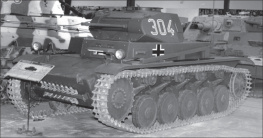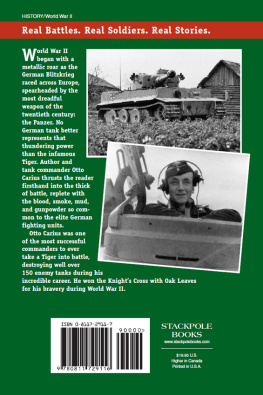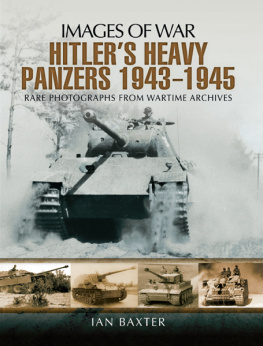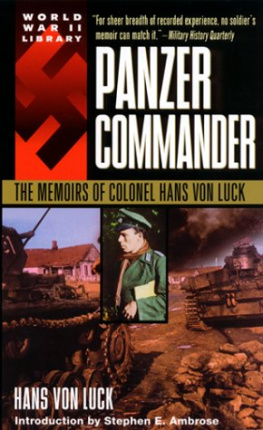
PANZER ACE
PANZER ACE
The Memoirs of an Iron Cross Panzer Commander From Barbarossa to Normandy
Richard Freiherr von Rosen
Foreword by Robert Forcyzk
Translated by Geoffrey Brooks
Panzer Ace: The Memoirs of an Iron Cross Panzer Commander from Barbarossa to Normandy
Greenhill Books
Greenhill Books, c/o Pen & Sword Books Ltd,
47 Church Street, Barnsley, S. Yorkshire, S70 2AS
For more information on our books, please visit
or write to us at the above address.
English language translation Greenhill Books, 2018
Robert Forczyk foreword Greenhill Books, 2018
Main text Verlagshaus Wrzburg GmbH & Co. KG
Flechsig Verlag
Beethovenstrae 5 B
D-97080 Wrzburg
Germany
www.verlagshaus.com
Publishing History
Richard Freiherr von Rosens Als Panzeroffizier in Ost und West was first published by Flechsig Verlag, Germany. This 2018edition is published by Greenhill Books, London, with a new foreword by Robert Forczyk.
All rights reserved. No part of this publication may be reproduced, stored in or introduced into a retrieval system, or transmitted, in any form, or by any means (electronic, mechanical, photocopying, recording or otherwise) without the prior written permission of the publisher. Any person who does any unauthorized act in relation to this publication may be liable to criminal prosecution and civil claims for damages.
CIP data records for this title are available from the British Library
ISBN 978-1-78438-266-7
eISBN 978-1-78438-268-1
Mobi ISBN 978-1-78438-267-4
Translators Note
The German ranks for the Panzer Arm appearing in this book had the following British Army equivalents:
| Panzerschtze/Funker | Gunner/Radio operator |
| Gefreiter | Private, trained soldier |
| Obergefreiter | Lance-Corporal (non NCO) |
| Unteroffizier | Corporal (basic NCO grade) |
| Feldwebel | Sergeant |
| Oberfeldwebel | Staff Sergeant |
| Hauptfeldwebel | Spiess Company Sergeant-Major |
| Leutnant | Junior Lieutenant |
| Oberleutnant | Senior Lieutenant |
| Hauptmann | Captain |
| Major | Major |
| Oberstleutnant | Lieutenant-Colonel |
| Oberst | Colonel |
Following German artillery tradition, an abteilung was in general a formation of three fighting companies plus an HQ company and the usual range of support services. Its nearest equivalent would be a battalion. Typically an abteilung might have forty-five panzers.
A company at full strength might have around fourteen panzers and be composed of several platoons, perhaps four panzers per platoon.
The unit abbreviations used in this book in ascending order are:
| PzAbt | Panzer Abteilung |
| PzRgt | Panzer Regiment |
| PzBrig | Panzer Brigade |
| PzDiv | Panzer Division |
Foreword by Robert Forczyk

While there are many, many books about tanks in the Second World War, relatively few have been written by men who served as tank platoon leaders in that conflict. Two of the more memorable books in this category were Bob Crisps Brazen Chariots (1959), about his service in 3 RTR in 1941, and Otto Cariuss Tigers in the Mud (1960), about his service in Heavy PzAbt 502 in 19434. In armoured warfare, it is young tank platoon leaders who lead from the front, but unfortunately few of these men survived the war. Most accounts of armoured warfare were written by higher-level officers like Guderian or staff officers who did not actually serve on tanks at the small unit level. Consequently, Panzer Ace , written by Richard Freiherr von Rosen, is a welcome addition to the exceedingly short list of Second World War tank platoon leader memoirs. As a former Cold War-era tank platoon leader myself, I found Panzer Ace to be a gripping front-line account that amply brings to life the day-to-day responsibilities and challenges facing junior leaders at the spearpoint of mobile warfare.
The 18-year-old von Rosen entered the German Army (Heer) in 1940 and was trained as a tanker during the winter of 1940/1. His first taste of battle was as a gunner on a Panzer III medium tank during the opening stages of Operation Barbarossa in 1941. In his opening vignettes, the author details the intense effort that the Heer put into training its tankers, how tank crews were formed and vehicles provisioned for the campaign in Russia. I was surprised by the authors frank admission of widespread looting (and intoxication) by members of his battalion as they captured Russian towns and a rather casual attitude towards local security in occupied areas. In Bob Crisps earlier memoir, he referred to similar proclivities as swanning about. This is not how the Panzer spearheads are depicted in official histories, looting and drinking their way across Russia. On the other hand, the authors description of his crews relentless quest to acquire creature comforts rings quite consistent with the behaviour of tankers from other armies. In von Rosens unvarnished account, tankers are filthy, dog-tired and focused on simple tasks, like keeping the air filters clean. Combat was short and violent. In his first real action, the authors entire five-tank platoon was knocked out by concealed anti-tank guns and only eleven of twenty-five crewmen survived, after evading capture. However, tank units also suffered many non-battle casualties and von Rosen was injured in an accident in August 1941 and sent back to Germany to recover.
Von Rosen was certainly fortunate in missing most of the 1942 campaign in Russia and then being reassigned to the newly created Heavy PzAbt 502, the first German battalion equipped with the new Tiger I heavy tank. During his recovery, von Rosen received additional training and was commissioned as a Leutnant. In late December 1942, his unit was hurriedly transferred to southern Russia in response to the catastrophe at Stalingrad. It was in January 1943, on the frozen Kalmuck steppes, that von Rosen gained his first experience as a tank platoon leader. His unit, redesignated as Heavy PzAbt 503, conducted a fighting withdrawal back to Rostov, then to the Kharkov area. Armoured delaying operations are one of the toughest missions that a platoon leader can receive, and conducting it amidst a Russian winter was no small accomplishment. Afterwards, von Rosen describes the lead-up to Operation Zitadelle , the German offensive against the Kursk bulge, with interesting details about training and preparations. One of the authors most telling observations about Kursk was, we would discover that the Russian soldier we would face was no longer the man of 19412, but a soldier our equal in fighting efficiency and morale. The detailed descriptions that von Rosen provides of tank combat during the Battle of Kursk are some of the best that I have read, rich with significant points that are often overlooked in other accounts. Not surprisingly, given the fierce Soviet resistance, von Rosen was wounded in action during the battle and again sent back to Germany.
Next page














